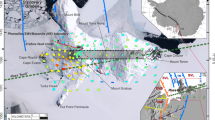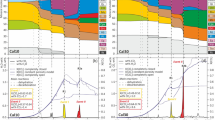Abstract
A THIN reservoir of free aqueous or carbonic fluids at mid-crustal levels, perhaps in the form of water sills1, has been suggested as the source of fault-transmitted metasomatizing fluids2–4, as the cause of observed deep crustal electrical conductivity and anomalous seismic reflectivity5, and as a lubricated potential detachment zone for thin-skin tectonics6. A problem with this hypothesis is that estimated crustal permeabilities are too high to permit long-term retention of such fluids7,8. Most mechanisms suggested for achieving the required permeability reduction rely on maintaining unusually low porosity 2,6,9,10. Because porosity creation, by tectonic deformation, fluid release or infiltration, is a ubiquitous process, permeability reductions achieved by these mechanisms are hard to sustain for long periods of time. A sealing (permeability reduction) mechanism that can operate in the presence of significant porosity is required. Here I propose that the required mechanism is capillary sealing by immiscible CO2-H2O mixtures derived from rising volatiles.
This is a preview of subscription content, access via your institution
Access options
Subscribe to this journal
Receive 51 print issues and online access
$199.00 per year
only $3.90 per issue
Buy this article
- Purchase on Springer Link
- Instant access to full article PDF
Prices may be subject to local taxes which are calculated during checkout
Similar content being viewed by others
References
Fyfe, W. S., Price, N. J. & Thomson, A. B. Fluids in the Earth's crust (Developments in Geochemistry Vol. 1, Elsevier, New York, 1978).
Etheridge, M. A., Wall, V. J., Cox, S. F. & Vernon, R. H. J. geophys. Res. 89, 4344–4358 (1984).
Sibson, R. H. Geology 15, 701–704 (1987).
Rice, J. R. in Fault Mechanics and Transport Properties of Rocks (eds. Evans, B & Wong, T.-F. 475–503 (Academic, New York, 1992).
Jones, A. G. Geophys. J. 89, 7–18 (1987).
Bailey, R. C., Geophys. Res. Lett. 17, 1129–1132 (1990).
Brace, W. F. Int. J. Rock Mech. Miner. Sci. Geomech. Abstr. 17, 241–251 (1980).
Hyndman, R. D. & Shearer, P. M. Geophys. J. Int. 98, 343–365 (1989).
Walder, J. & Nur, A. J. geophys. Res. 89, 11539–11548 (1984).
Marquis, G. & Hyndman, R. D. Geophys. J. Int. 110, 91–105 (1992).
Thomson, A. B. Nature 358, 295–302 (1992).
Sibson, R. H., J. struct. Geol. 11, 873–877 (1989).
Fyfe, W. S. in Saline Water and Gases in Crystalline Rocks (eds Fritz, P. & Frape, S. K.) 1–3 (Spec. Pap. No. 33, Geol. Ass. Canada, Ottawa, 1987).
Yardley, B. W. D. Nature 323, 111 (1986).
Thompson, A. B. & Connolly, J. A. D. Tectonophysics 182, 47–55 (1990).
Secor, D. T. & Pollard, D. D. Geophys. Res. Lett. 2, 510–513 (1975).
Yardley, B. W. D. & Bottrell, S. H. Geophys. 16, 199–202 (1988).
Frantz, J. D., Popp, R. K. & Hoering, T. C. Chem. Geol. 98, 237–255 (1992).
Zhang, Y. G. & Frantz, J. D. Chem. Geol. 74, 289–308 (1989).
Bowers, T. S. & Helgeson, H. C. Geochim. cosmochim. Acta 47, 1247–1275 (1983).
Johnson, E. L. Geology 19, 925–928 (1991).
Frape, S. K. & Fritz, P. in Saline Water and Gases in Crystalline Rocks (eds Fritz, P. & Frape, S. K.) 19–37 (Spec. Pap. No. 33, Geol. Ass. Canada, Ottawa, 1987).
Stegemeier, G. L. in Improved Oil Recovery by Surfactant and Polymer Flooding (eds Shah, D. O. & Schechter, R. S.) 55–91 (Academic, New York, 1977).
Dullien, F. A. L., Lai, F. S. Y. & MacDonald, I. F. J. Colloid Interface Sci. 109, 201–218 (1986).
Katz, A. J. & Trugman, S. A. J. Colloid Interface Sci. 123, 8–13 (1988).
Nassau, K. & Schonhorn, H. Gems Gemol. 15, 354–360 (1978).
Watson, E. B. & Brenan, J. M. Earth planet. Sci. Lett. 85, 497–515 (1987).
Adamson, A. W. Physical Chemistry of Surfaces 70 (Interscience, New York, 1960).
Rowlinson, J. S. & Widom, B. Molecular Theory of Capillarity (Clarendon, Oxford, 1982).
Brace, W. F., Walsh, J. B. & Frangos, W. T. J. geophys. Res. 73, 2225–2236 (1968).
Mohanty, K. K., Davis, H. T. & Scriven L. E. in Proc. Soc. Petrol. Engrs 55th A. Conf. (Publ. No. 9406, Soc. Petrol Engrs, Dallas, 1980).
Author information
Authors and Affiliations
Rights and permissions
About this article
Cite this article
Bailey, R. Fluid trapping in mid-crustal reservoirs by H2O–CO2 mixtures. Nature 371, 238–240 (1994). https://doi.org/10.1038/371238a0
Received:
Accepted:
Issue Date:
DOI: https://doi.org/10.1038/371238a0
This article is cited by
-
Electrical conductivity structure of Aravalli and Tural hot springs (western part of DVP) inferred from magnetotelluric data
Journal of Earth System Science (2022)
-
Rapid migration of CO2-rich micro-fluids in calcite matrices
Scientific Reports (2018)
-
Seismicity of the Koyna region and regional tectonomagmatism of the Western Margin (India)
Pure and Applied Geophysics PAGEOPH (1995)
-
How wet is the Earth's crust?
Nature (1994)
Comments
By submitting a comment you agree to abide by our Terms and Community Guidelines. If you find something abusive or that does not comply with our terms or guidelines please flag it as inappropriate.



